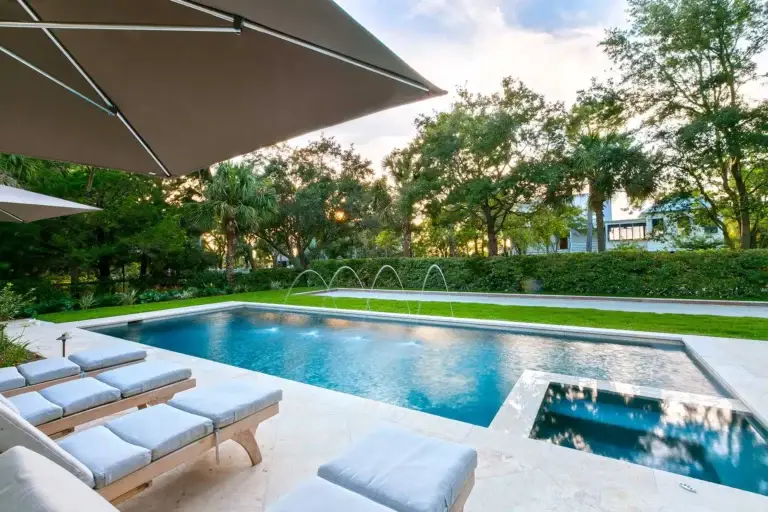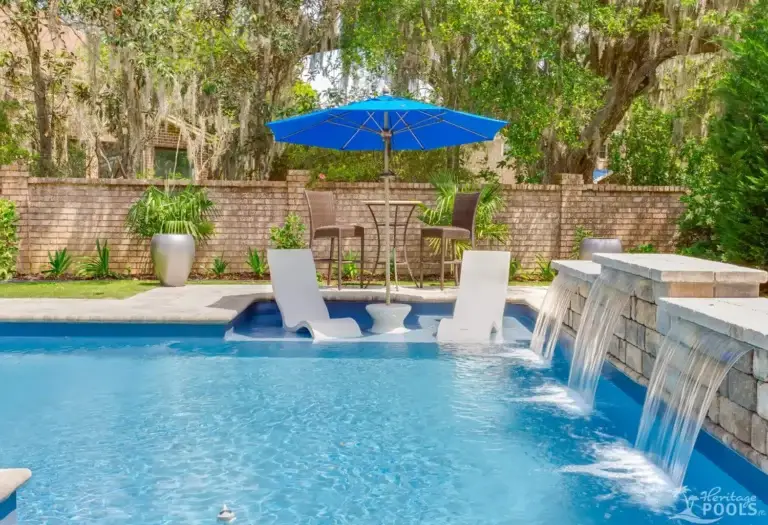We know investing in a swimming pool is a big, yet fun, decision. But it is one of the best decisions you can make, as a backyard swimming pool can bring many years of enjoyment and wonderful memories into your life. The following guide to buying a pool will help bring clarity to the process.
Despite being able to choose a pick-and-play pool, like a fiberglass shell, the process to install, logistics, location, permits, and options can be a more intricate one than you might think. This complete guide with linked supplemental information on buying an inground pool will help you consider a multitude of factors.
- What You’ll Need to Get Started
- Things to Consider
- Choosing a Pool Company
- Types of Pools
- Pool Options
- Designing Your Pool
- Building Your Pool
- Paying For Your Pool
What You’ll Need to Get Started
Are you currently building your home?: If you’re currently building your home, then we typically work with the builder/contractor to coordinate the current plans with the location, size and type of proposed pool.
Do you currently own the home?: If you currently own the home then we will need a current as-built survey (see example below) of the property that includes the home, dimensions, easements and boundaries. The reason for this is because there are building restrictions when it comes to pool building. We do not want to build the pool into an easement that results in a fine and the pool being moved. It’s best to know the scale and location of the pool at the very beginning.
It’s also helpful to take notes and pictures of anything that you have seen that you’d like to add to your new pool and backyard. These will be given to your designer. Some companies do not require an updated survey when installing a pool, which can sometimes result in fines from the city if you’re within an easement and can also result in you being forced to move the pool to a new location in your yard.

Things You Need to Consider
- Do your own research about your zoning laws. Know the rules and restrictions concerning pools for your property.
- Can you consistently maintain your new pool or should you hire help? A well cared for pool will can add great resale value to a home, but a poorly cared for pool can do the exact opposite. Ask the pool companies your considering working with if they offer pool maintenance packages.
- Have you considered post-pool landscaping? When a pool company comes in to dig and work, most of your yard is going to be turned inside out. Consult with a landscaping company to determine your post-construction plans.
- Have you planned for fencing? Fencing around the perimeter of the pool is mandatory.
- There are a lot of companies that are great – when things go smoothly. Do your research on the pool companies you’re considering to find out how they’ve handled problems with previous clients.
- Have you received multiple quotes? Not all companies include everything in the initial quote and can differ from other pool companies that do.
- Have you planned on updating your homeowner’s insurance? “If you are thinking of buying or building a swimming pool, it’s best to contact your home insurance company first.” – ValuePengiun
Choosing a Pool Builder
Just like there are a lot of options for pools, there are just as many options for pool contractors. There are a few factors, other than just price, you should look for when choosing your pool contractor.
- Do they service and maintain the pools they are building?
- What do their Google reviews say?
Types of Swimming Pools
There are many different types of pools but we will be talking inground pools in this guide and choosing a swimming pool project can come down to aspects like budget, soil, slope, and installation time to name a few.

Concrete Pools: Similar application methods, same result. Shotcrete pools are “shot” with a concrete truck and tube. Gunite pools are “shot” with a mixture of forced material and water that meets and mixes at the end of the hose right before it is applied.
Elevated Concrete: Elevated pools are much more intricate than a standard inground pool. Geotechnical assessment and engineered footings have to be completed prior to the pool being built. Foresight into settlement and movement must be considered, especially when adding infinity edges. You don’t want to be looking out over your pool and see a slanted horizon.
Vinyl: A vinyl pool typically has polymer walls and a concrete or basecrete base, upon which sits the vinyl liner.
Fiberglass Pool: First seen in the 1950s and greatly advanced throughout the 90s and 2000s, fiberglass pools have boomed in popularity. Many homeowners lean towards these pools because they can choose their shape and it is delivered. It cuts down on the design process.
Plunge/Cocktail Pool: We get this inquiry all the time. There are a lot of smaller, tighter lots in Charleston, so a plunge pool can be a good option. These are typically smaller pools, around 10’x16′, that are perfect for cooling off in the summer months.
Spool/Swim Spa: When you start adding custom seating, jets, heaters and resistance swimming devices this is when is becomes a spool. Both the plunge pool and Spool are great for smaller entertaining areas.
See a full list of Heritage Pools’ Completed Projects.
Pool Options
-
90% reduction in water evaporation
-
70% reduction in pool heating costs
-
50% reduction in electricity costs
-
70% reduction in chemical use
Designing Your Pool

Building the Pool of Your Dreams
-
“Painting” Your Pool – Once you have decided on a pool design with a designer, the designer and project manager will come out to your house to spray paint the pool in the yard, along with the decking, so you can see the sizing and placement in real life. They will also be checking for high points in the yard and any other impediments to the current design.
-
Equipment and Excavation – Pool projects need at least 8 feet of access to get to the backyard. Ideally, these access points will be through your own property but sometimes a neighbor permission form is needed to borrow some yard to access the pool site. If it is tight, don’t surprised if fences, trees, or bushes need to be removed.
-
Installing the Pool – Depending on the type of pool you choose, the process can range between 6-15 weeks, with concrete pools taking up the longest timeline. The process varies by pool style.
-
Coping and Decking – Installing your chosen stone, concrete, block, etc. occurs towards the end of the design process once the initial shape and type of pool have been laid out.
-
Pool School – Led by one of our specialists, this one-on-one process teaches you everything you need to know to keep your pool functioning properly.




